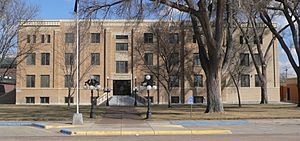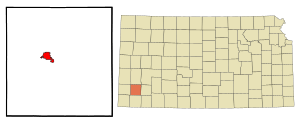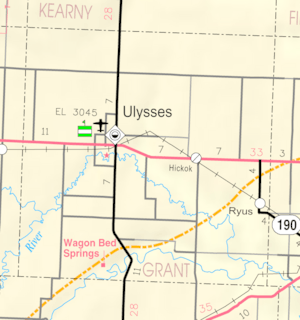Ulysses, Kansas facts for kids
Quick facts for kids
Ulysses, Kansas
|
|
|---|---|
|
City and County seat
|
|

Grant County courthouse (2015)
|
|

Location within Grant County and Kansas
|
|

|
|
| Country | United States |
| State | Kansas |
| County | Grant |
| Founded | 1885 |
| Incorporated | 1921 |
| Named for | Ulysses S. Grant |
| Area | |
| • Total | 3.30 sq mi (8.54 km2) |
| • Land | 3.23 sq mi (8.36 km2) |
| • Water | 0.07 sq mi (0.18 km2) |
| Elevation | 3,055 ft (931 m) |
| Population
(2020)
|
|
| • Total | 5,788 |
| • Density | 1,753.9/sq mi (677.8/km2) |
| Time zone | UTC-6 (CST) |
| • Summer (DST) | UTC-5 (CDT) |
| ZIP code |
67880
|
| Area code | 620 |
| FIPS code | 20-71975 |
| GNIS ID | 471718 |
Ulysses (pronounced /juːˈlɪsɪs/) is a city in Grant County, Kansas, United States. It is the county seat, which means it's where the county government is located. The city is named after Ulysses S. Grant, who was the 18th President of the United States. In 2020, about 5,788 people lived in Ulysses.
Contents
History of Ulysses
The First Ulysses Town
The first town of Ulysses was started in June 1885. It was about two miles east of where Ulysses is today. Just six weeks later, the town got its first newspaper, called the Grant County Register.
From 1892 to 1893, Ulysses had two weekly newspapers. These were the Ulysses Tribune and the Grant County Republican. The Grant County Republican is the oldest business still running in Grant County today. It is now known as the Ulysses News.
In 1885, the Grant County Register newspaper wrote about Ulysses. It said the town was new and busy. It mentioned that just a month before, 6,000 cattle were in the area. Now, there was a growing city. The town offered good deals for people who wanted to start businesses. It already had several buildings and a hotel with 16 rooms.
In 1887, the Ulysses Tribune newspaper also wrote about the town. It called Ulysses the "booming town" of Grant County. It said Ulysses had many natural benefits. It was on the path of a new east-west railroad. Another railroad was planned from Lakin south to Ulysses. This meant the town would have two railroads. Also, clean water was easy to find at only 30 feet deep. In other towns, water was much deeper.
At its busiest, "Old" Ulysses had many places. It had four hotels, including the famous Hotel Edwards. This hotel was later moved to "New Ulysses" in 1909. Today, it is part of The Historic Adobe Museum. The town also had twelve restaurants, twelve saloons, a bank, and six gambling houses. There was a large school, a church, a newspaper office, and an opera house. About 1,500 people lived there.
When the town moved in 1909, the opera house became the Grant County courthouse. County offices were on the first floor. High school classes were held on the second floor. This was until a new high school building opened in 1923. In the 1930s, the current courthouse was built. The old opera house building was then taken down.
In February 1888, the Kansas Supreme Court said Ulysses was the temporary county seat. Another town, Cincinnati, also wanted to be the county seat. This led to a court fight. Grant County itself was also changing its borders. All these issues were settled by June 1888. That's when the first county officers were officially sworn in.
The years from 1885 to 1889 were a time of fast growth for Ulysses. But in the second half of 1889, a drought hit. This caused the town's growth to slow down.
Moving the Town
By the early 1900s, Ulysses was the only town left in Grant County. By 1906, times were very hard for the town. The population had shrunk from a busy town to only about 40 people.
In February 1909, 24 years after it was first founded, the people of "Old" Ulysses started to move the town. They moved it to where it is now.
The first town of Ulysses had borrowed a lot of money for improvements. But these improvements were never made. The money was taken by dishonest people. "Old" Ulysses went from about 1,500 people in the late 1880s to only 100 in 1908. The town faced a huge debt of $84,000. This was a lot of money, and there was nothing to show for it.
Some people who had lent money sued the city. They won judgments for thousands of dollars because the city hadn't paid interest. The people of Ulysses had to pay very high taxes to cover these debts. Their property taxes went up by 600%. Their personal property taxes went up by 362%.
After paying these very high taxes for a year, the citizens made a big decision. They decided to move their homes and businesses off the old town site. They also moved out of the school district. This was a very unusual decision for a town to make. The way they worked together to do this is an important part of Ulysses' history.
The city leaders bought a new piece of land about two miles west. This land was given to the New Ulysses Town Company. After the new town site was planned, the move began. It started in February 1909 and lasted about three months. Large buildings were moved on skids. Smaller ones were put on wagons. Horses pulled the loads. They had to move the buildings downhill, across a valley, and then uphill to the new spots.
Moving some buildings took several days. The biggest buildings were cut into parts and moved one section at a time. It took 60 horses to move just one part of the old hotel. The courthouse and post office stayed at the old site until June 1909. That's when New Ulysses was officially named the county seat.
The move was finished in June 1909. Every person, with their homes and businesses, moved from the old town site. They moved to the new spot, two and a half miles west. They crossed a valley and built a new town called New Ulysses. After the move, the old town site was left just as it was found: an empty prairie.
Proposed State of West Kansas
In 1992, Ulysses was chosen as the possible capital for a new state called "West Kansas". The city hosted a meeting to write a constitution for this new state. This idea was a protest against Governor Joan Finney. She had increased taxes in rural areas and cut funding for rural schools. However, no official request to become a new state was ever sent to the Kansas Legislature. The idea quickly faded away.
Geography and Climate
Ulysses is located at 37°34′48″N 101°21′27″W / 37.58000°N 101.35750°W. The city covers about 3.26 square miles (8.44 square kilometers). Most of this area is land, with a small part being water.
Climate in Ulysses
Ulysses has a cold semi-arid climate. This means it is generally dry and has hot summers and cold winters. The hottest temperature ever recorded in Ulysses was 116°F (47°C) on July 28, 1894. The coldest temperature was -27°F (-33°C) on January 19, 1984.
| Climate data for Ulysses, Kansas, 1991–2020 normals, extremes 1893–present | |||||||||||||
|---|---|---|---|---|---|---|---|---|---|---|---|---|---|
| Month | Jan | Feb | Mar | Apr | May | Jun | Jul | Aug | Sep | Oct | Nov | Dec | Year |
| Record high °F (°C) | 83 (28) |
90 (32) |
98 (37) |
103 (39) |
103 (39) |
111 (44) |
116 (47) |
109 (43) |
107 (42) |
100 (38) |
91 (33) |
86 (30) |
116 (47) |
| Mean maximum °F (°C) | 68.7 (20.4) |
75.9 (24.4) |
83.8 (28.8) |
90.1 (32.3) |
96.0 (35.6) |
101.9 (38.8) |
103.8 (39.9) |
100.9 (38.3) |
98.6 (37.0) |
92.5 (33.6) |
79.5 (26.4) |
68.4 (20.2) |
105.0 (40.6) |
| Mean daily maximum °F (°C) | 45.6 (7.6) |
49.8 (9.9) |
59.7 (15.4) |
68.2 (20.1) |
78.2 (25.7) |
88.6 (31.4) |
92.8 (33.8) |
90.4 (32.4) |
83.5 (28.6) |
70.8 (21.6) |
57.2 (14.0) |
46.5 (8.1) |
69.3 (20.7) |
| Daily mean °F (°C) | 30.9 (−0.6) |
34.6 (1.4) |
43.4 (6.3) |
52.1 (11.2) |
62.6 (17.0) |
73.6 (23.1) |
78.1 (25.6) |
76.1 (24.5) |
68.2 (20.1) |
54.7 (12.6) |
41.7 (5.4) |
32.0 (0.0) |
54.0 (12.2) |
| Mean daily minimum °F (°C) | 16.2 (−8.8) |
19.3 (−7.1) |
27.1 (−2.7) |
36.0 (2.2) |
47.0 (8.3) |
58.6 (14.8) |
63.4 (17.4) |
61.8 (16.6) |
52.9 (11.6) |
38.7 (3.7) |
26.2 (−3.2) |
17.5 (−8.1) |
38.7 (3.7) |
| Mean minimum °F (°C) | −0.3 (−17.9) |
4.2 (−15.4) |
11.4 (−11.4) |
23.1 (−4.9) |
33.6 (0.9) |
46.8 (8.2) |
55.4 (13.0) |
53.8 (12.1) |
38.9 (3.8) |
24.1 (−4.4) |
10.3 (−12.1) |
0.2 (−17.7) |
−6.2 (−21.2) |
| Record low °F (°C) | −27 (−33) |
−20 (−29) |
−18 (−28) |
8 (−13) |
19 (−7) |
32 (0) |
43 (6) |
40 (4) |
25 (−4) |
3 (−16) |
−9 (−23) |
−21 (−29) |
−27 (−33) |
| Average precipitation inches (mm) | 0.43 (11) |
0.32 (8.1) |
1.08 (27) |
1.51 (38) |
1.96 (50) |
2.59 (66) |
2.88 (73) |
2.87 (73) |
1.34 (34) |
1.60 (41) |
0.49 (12) |
0.69 (18) |
17.76 (451.1) |
| Average snowfall inches (cm) | 4.2 (11) |
3.1 (7.9) |
3.8 (9.7) |
1.4 (3.6) |
0.1 (0.25) |
0.0 (0.0) |
0.0 (0.0) |
0.0 (0.0) |
0.0 (0.0) |
0.1 (0.25) |
1.3 (3.3) |
3.8 (9.7) |
17.8 (45.7) |
| Average precipitation days (≥ 0.01 in) | 2.8 | 3.2 | 4.4 | 5.7 | 7.2 | 7.7 | 8.3 | 7.7 | 4.7 | 4.3 | 3.1 | 3.1 | 62.2 |
| Average snowy days (≥ 0.1 in) | 2.2 | 2.3 | 1.5 | 0.4 | 0.1 | 0.0 | 0.0 | 0.0 | 0.0 | 0.2 | 0.9 | 2.2 | 9.8 |
| Source 1: NOAA | |||||||||||||
| Source 2: National Weather Service | |||||||||||||
People of Ulysses
| Historical population | |||
|---|---|---|---|
| Census | Pop. | %± | |
| 1890 | 198 | — | |
| 1920 | 103 | — | |
| 1930 | 1,140 | 1,006.8% | |
| 1940 | 824 | −27.7% | |
| 1950 | 2,243 | 172.2% | |
| 1960 | 3,157 | 40.7% | |
| 1970 | 3,779 | 19.7% | |
| 1980 | 4,653 | 23.1% | |
| 1990 | 5,474 | 17.6% | |
| 2000 | 5,960 | 8.9% | |
| 2010 | 6,161 | 3.4% | |
| 2020 | 5,788 | −6.1% | |
| U.S. Decennial Census 2010-2020 |
|||
Population in 2020
The 2020 United States census counted 5,788 people in Ulysses. There were 1,896 households and 1,229 families. The population density was about 1,792 people per square mile.
Most people in Ulysses were white (53.89%). A large part of the population, 51.1%, was Hispanic or Latino.
About 30.1% of households had children under 18. Most households (53.2%) were married couples. The average household had 2.9 people.
The average age in Ulysses was 31.7 years. About 29.8% of the people were under 18 years old.
Population in 2010
In the census of 2010, there were 6,161 people living in Ulysses. The population density was about 1,937 people per square mile.
About 78.7% of the people were White. About 49.0% of the population was Hispanic or Latino.
About 42.5% of households had children under 18. Most households (60.9%) were married couples living together. The average household size was 2.84 people.
The average age in the city was 32.4 years. About 31.6% of residents were under 18 years old.
Education
The public schools in Ulysses are part of the Ulysses USD 214 school district.
Transportation
Roads
U.S. Route 160 goes through Ulysses from east to west. It continues across the state of Kansas. K-25 (Kansas highway) runs north to south through the city and the state.
Air Travel
The Ulysses Airport (KULS) serves the area. It has two runways. One is 6,000 feet long, and the other is 4,600 feet long.
Media
Television
Ulysses is in the Wichita-Hutchinson, Kansas television market. This means people in Ulysses watch TV channels from those cities.
KDGU-LD is a TV station licensed to Ulysses. It broadcasts the signal of KDGL-LD from Sublette, Kansas.
Notable People
- Gary Bender, a sports announcer.
- Sheri Dew, the CEO of Deseret Book.
- Karen Dillon, a filmmaker and arts teacher.
- Sarah Noriega, an athlete who competed in the Olympics for women's volleyball.
- Eugene Pulliam, a newspaper publisher.
- Jedediah Smith (1799-1831), a famous mountain man and explorer. He was killed by Comanche warriors south of Ulysses.
Images for kids
See also
 In Spanish: Ulysses (Kansas) para niños
In Spanish: Ulysses (Kansas) para niños


